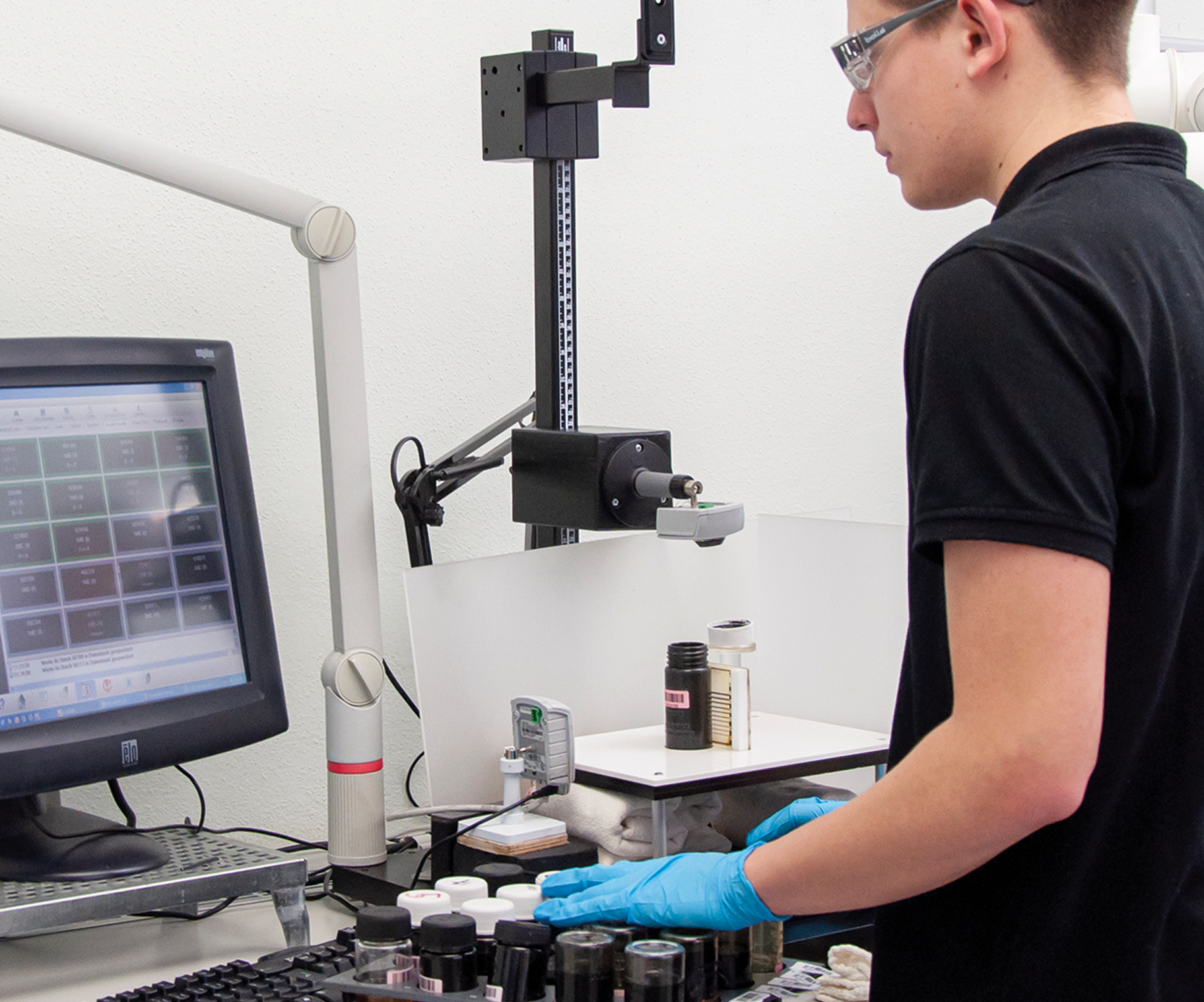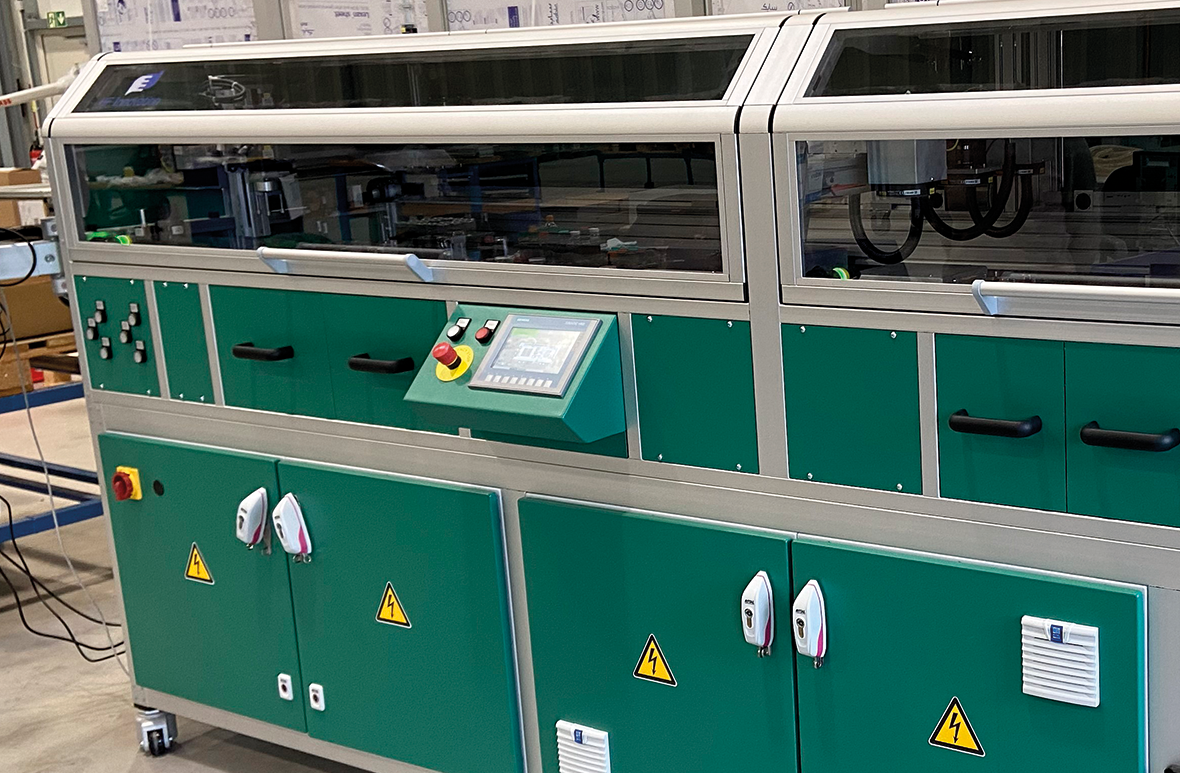Precise, fast and objective – Automated visual assessment
Publication year: 2023
This test device is unique! It was developed jointly by OELCHECK and HF-Innovation GmbH, which manufactured it according to our requirements. The innovative device ensures an even more objective assessment of the samples. It handles several work steps in one process and relieves our laboratory staff.

Until 2023 – manual, elaborate and subjective
Until December 2023 all samples received by OELCHECK were visually inspected by our laboratory technicians before further investigations were started and subjected to the so-called “crackle test” for the rapid detection of water. To do this, the sample bottles are first placed upside down, i.e. on the lid, stored upright. Any foreign substances in the oil fall to the white inner surface of the lid and are easily recognisable when the bottles is quickly turned over and opened. The laboratory technician’s first diagnostic view therefore immediately falls on the white inner surface of the lid seal, in which abnormalities in the lubricant are visible, e.g. in the form of particles. The inside of the lid and the well-lit, open sample bottle are captured by a camera. After the photograph is taken, an initial assessment is made of the appearance of the oil sample, its colour and any sediments in the lid by means of a comparative assessment.
The previous visual assessment was not only made up of many elaborate steps, but was inevitably subjective, because people do not all see e.g. colours the same.

Since 2024 – automated, fast and objective
Our new colleague, Automated Visual Assessment, was installed in the OELCHECK laboratory in the beginning of 2024. The interior of the device contains a variety of high-quality camera systems, special lighting equipment, motors, grippers, heating elements for the crackle test and a computer-assisted image evaluation.
The system holds up to 80 sample bottles per sequence and operates in multiple steps:
- A gripper takes one of the sample bottles on its lid and transports it to the first camera system. Here, the barcode of the sample is scanned, a photo of the sample bottle is taken and the various parameters, such as colour, turbidity and filling level, are automatically read out.
- The sample is now transported to the next photo station. The bottle is rotated and the lid removed so that the inside of the sample lid and any particles that may be deposited here are visible. A computer-assisted image evaluation reads out the degree of contamination. Photos are also taken from a bird’s eye view of the inside of the sample lid and of the opened bottle. As before, these photos will be included in the laboratory report for the customer.
- A pipette system takes a small amount from the sample and subjects it to a crackle test, a fast method of detecting free water. An oil drop (0.2 ml) is sprayed onto a 180 °C hot plate.
If the droplet contains more than 0.1 % or 1,000 ppm of water, it escapes from the oil with a crackling sound, often in conjunction with steam bubbles. Previously, this reaction was evaluated optically and thus subjectively by a laboratory technician, but now a camera system goes into action. It records the sequence of the reaction and evaluates it objectively. - From the remaining sample residue in the pipette, a part is placed in a tube for subsequent IR spectroscopy. The pipette is then cleaned in a washing station and dried with compressed air before it returns to action for the next sample.
During the crackle test and preparation of the sample quantity for IR spectroscopy, the sample bottle is closed again with its lid and returned to the batch by a gripper.

An idea became reality
We had the idea of automating the visual assessment for a long time. The thought of this just wouldn't let us go. In 2021, we finally contacted HF-Innovation GmbH. The company from Hörstel in Westphalia develops and supplies complete semi-automatic and fully automatic solutions for laboratory systems from preparation to fully integrated analysis. We had already had good experience with HF-Innovation GmbH in the complete automation of the determination of the PQ index.
And after initial consultations, it was soon clear this time too: We are tackling the new project together.
However, it was a long journey before the device became a reality. Countless real samples were repeatedly tested, values compared and improvements made. After installation in the OELCHECK laboratory, all processes needed to be precisely adapted and the device needed to be integrated into our laboratory information and management system, LIMS for short. Our LIMS developed by OELCHECK IT combines a wide range of different, coordinated processes. It captures all examination results and controls workflows.
OELCHECKER Spring 2023, page 8



